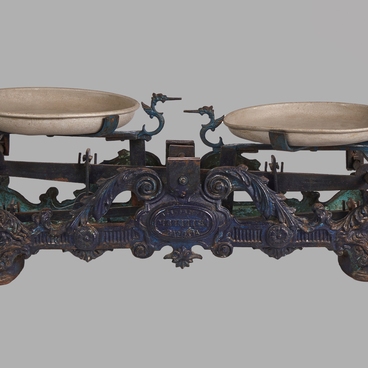The floor standing gramophone without the horn from the permanent exhibition of the Novorossiysk Museum was made in the form of a bedside table with legs. At first glance, it looks like an ordinary piece of furniture.
There is a well-known photograph showing the opera singer Fyodor Ivanovich Chaliapin, sitting in front of such a gramophone and listening to a record he sang. Floor standing gramophones were expensive and only the wealthy could afford them, so such gramophones were produced in small quantities. Only a few exhibits have survived to this day.
In the 20th century, the “Magic Nightstand” was a music playing device — a gramophone with a built-in “zither” — a string resonator that regulates the outgoing sound waves so that their amplitude and frequency range increase during acoustic resonance, while amplifying the volume and sound quality. The sound volume of a gramophone like this was regulated by opening the door of the built-in horn. Floor standing gramophones without horns had the best sound quality. Floor-standing gramophones, as well as gramophones with a horn, had different numbers of revolutions per minute: 70, 75, 80… 120. Only with time did the production of gramophones with a single number of revolutions (78) begin. At the bottom of the “bedside table”, there were several special compartments for storing records.
The floor standing gramophone presented in the permanent exhibition of the Novorossiysk Historical Museum-Reserve belonged to the famous writer and winner of two Stalin Prizes Fyodor Vasilyevich Gladkov. Fyodor Vasilievich had a lot to do with Novorossiysk. He lived in this city at various times for a total of eight years. His main work — the novel “Cement” — was dedicated to Novorossiysk cement workers who restored factories and the city after the Civil War. The Novorossiysk Museum houses an exhibition dedicated to the writer.
Music played an important role in the life of the Gladkov family. Fyodor Vasilyevich had a beautiful voice, played the mandolin, and had an excellent collection of gramophone records. Fyodor Vasilyevich bought the floor standing gramophone in the 1930s in a thrift store. The gramophone is still in working order.
There is a well-known photograph showing the opera singer Fyodor Ivanovich Chaliapin, sitting in front of such a gramophone and listening to a record he sang. Floor standing gramophones were expensive and only the wealthy could afford them, so such gramophones were produced in small quantities. Only a few exhibits have survived to this day.
In the 20th century, the “Magic Nightstand” was a music playing device — a gramophone with a built-in “zither” — a string resonator that regulates the outgoing sound waves so that their amplitude and frequency range increase during acoustic resonance, while amplifying the volume and sound quality. The sound volume of a gramophone like this was regulated by opening the door of the built-in horn. Floor standing gramophones without horns had the best sound quality. Floor-standing gramophones, as well as gramophones with a horn, had different numbers of revolutions per minute: 70, 75, 80… 120. Only with time did the production of gramophones with a single number of revolutions (78) begin. At the bottom of the “bedside table”, there were several special compartments for storing records.
The floor standing gramophone presented in the permanent exhibition of the Novorossiysk Historical Museum-Reserve belonged to the famous writer and winner of two Stalin Prizes Fyodor Vasilyevich Gladkov. Fyodor Vasilievich had a lot to do with Novorossiysk. He lived in this city at various times for a total of eight years. His main work — the novel “Cement” — was dedicated to Novorossiysk cement workers who restored factories and the city after the Civil War. The Novorossiysk Museum houses an exhibition dedicated to the writer.
Music played an important role in the life of the Gladkov family. Fyodor Vasilyevich had a beautiful voice, played the mandolin, and had an excellent collection of gramophone records. Fyodor Vasilyevich bought the floor standing gramophone in the 1930s in a thrift store. The gramophone is still in working order.






